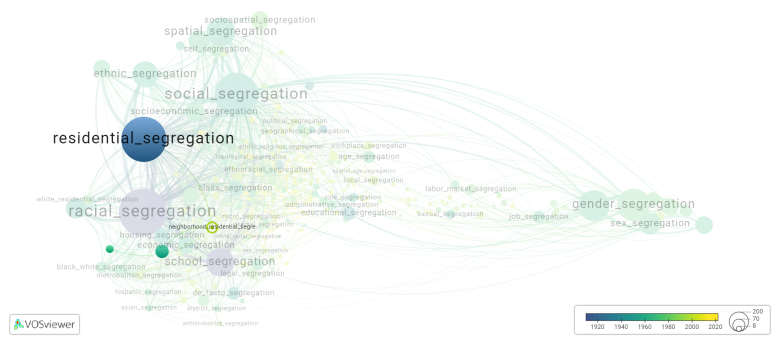Neighborhood residential segregation: Difference between revisions
(Creating page) |
(Creating page) |
||
| (13 intermediate revisions by the same user not shown) | |||
| Line 1: | Line 1: | ||
===== Date and country of first publication<ref>Date and country of first publication as informed by the Scopus database (December 2023).</ref>===== | |||
2007<br> | 2007<br> | ||
United States | |||
===== Definition ===== | |||
Neighborhood residential segregation refers to the phenomenon where individuals of a particular race, ethnicity, or socioeconomic status are concentrated in specific neighborhoods or geographic areas. This segregation can occur due to historical patterns of discriminatory housing policies, socioeconomic disparities, institutional racism, and personal preferences. Residential segregation can have significant implications for access to resources, opportunities, and quality of life for individuals living in segregated neighborhoods. It can also perpetuate existing inequalities and contribute to social division and disparities between different groups within a community. Efforts to address residential segregation often involve policies and initiatives aimed at promoting diversity, inclusivity, and equal access to housing and community resources for all residents. | Neighborhood residential segregation refers to the phenomenon where individuals of a particular race, ethnicity, or socioeconomic status are concentrated in specific neighborhoods or geographic areas. This segregation can occur due to historical patterns of discriminatory housing policies, socioeconomic disparities, institutional racism, and personal preferences. Residential segregation can have significant implications for access to resources, opportunities, and quality of life for individuals living in segregated neighborhoods. It can also perpetuate existing inequalities and contribute to social division and disparities between different groups within a community. Efforts to address residential segregation often involve policies and initiatives aimed at promoting diversity, inclusivity, and equal access to housing and community resources for all residents. | ||
==See also== | ==See also== | ||
==Related segregation forms== | |||
Neighborhood residential segregation is frequently discussed in the literature with the following segregation forms: | |||
[[residential segregation]], [[neighborhood segregation]], [[racial segregation]] | |||
[[File:neighborhood_residential_segregation.png|780x780px]] | |||
This visualization is based on the study [[Segregation_Wiki:About| The Multidisciplinary Landscape of Segregation Research]]. | |||
For the complete network of interrelated segregation forms, please refer to: | |||
* [https://tinyurl.com/2235lkhw First year of publication] | |||
* [https://tinyurl.com/2d8wg5n3 Louvain clusters] | |||
* [https://tinyurl.com/223udk5r Betweenness centrality] | |||
* [https://tinyurl.com/244d8unz Disciplines in which segregation forms first emerged (Scopus database).] | |||
==References== | ==References== | ||
== | ==Notes== | ||
<references /> | |||
{{NoteAI}} | |||
==Neighborhood residential segregation appears in the following literature== | |||
Lee M.-A., Ferraro K.F. (2007). Neighborhood residential segregation and physical health among hispanic Americans: Good, bad, or benign?. ''Journal of Health and Social Behavior'', ''48''(2), 131-148. American Sociological Association.https://doi.org/10.1177/002214650704800203 | |||
Lee M.-A. (2009). Neighborhood residential segregation and mental health: A multilevel analysis on Hispanic Americans in Chicago. ''Social Science and Medicine'', ''68''(11), 1975-1984. https://doi.org/10.1016/j.socscimed.2009.02.040 | |||
Osypuk T.L., Bates L.M., Acevedo-Garcia D. (201). Another Mexican birthweight paradox? The role of residential enclaves and neighborhood poverty in the birthweight of Mexican origin infants. ''Social Science and Medicine'', ''70''(4), 550-560. https://doi.org/10.1016/j.socscimed.2009.10.034 | |||
Parisi D., Lichter D.T., Taquino M.C. (2011). Multi scale residential segregation: Black exceptionalism and America's changing color line. ''Social Forces'', ''89''(3), 829-852. https://doi.org/10.1353/sof.2011.0013 | |||
Latest revision as of 07:17, 16 October 2024
Date and country of first publication[1][edit | edit source]
2007
United States
Definition[edit | edit source]
Neighborhood residential segregation refers to the phenomenon where individuals of a particular race, ethnicity, or socioeconomic status are concentrated in specific neighborhoods or geographic areas. This segregation can occur due to historical patterns of discriminatory housing policies, socioeconomic disparities, institutional racism, and personal preferences. Residential segregation can have significant implications for access to resources, opportunities, and quality of life for individuals living in segregated neighborhoods. It can also perpetuate existing inequalities and contribute to social division and disparities between different groups within a community. Efforts to address residential segregation often involve policies and initiatives aimed at promoting diversity, inclusivity, and equal access to housing and community resources for all residents.
See also[edit | edit source]
Related segregation forms[edit | edit source]
Neighborhood residential segregation is frequently discussed in the literature with the following segregation forms:
residential segregation, neighborhood segregation, racial segregation

This visualization is based on the study The Multidisciplinary Landscape of Segregation Research.
For the complete network of interrelated segregation forms, please refer to:
References[edit | edit source]
Notes[edit | edit source]
- ↑ Date and country of first publication as informed by the Scopus database (December 2023).
At its current state, this definition has been generated by a Large Language Model (LLM) so far without review by an independent researcher or a member of the curating team of segregation experts that keep the Segregation Wiki online. While we strive for accuracy, we cannot guarantee its reliability, completeness and timeliness. Please use this content with caution and verify information as needed. Also, feel free to improve on the definition as you see fit, including the use of references and other informational resources. We value your input in enhancing the quality and accuracy of the definitions of segregation forms collectively offered in the Segregation Wiki ©.
Neighborhood residential segregation appears in the following literature[edit | edit source]
Lee M.-A., Ferraro K.F. (2007). Neighborhood residential segregation and physical health among hispanic Americans: Good, bad, or benign?. Journal of Health and Social Behavior, 48(2), 131-148. American Sociological Association.https://doi.org/10.1177/002214650704800203
Lee M.-A. (2009). Neighborhood residential segregation and mental health: A multilevel analysis on Hispanic Americans in Chicago. Social Science and Medicine, 68(11), 1975-1984. https://doi.org/10.1016/j.socscimed.2009.02.040
Osypuk T.L., Bates L.M., Acevedo-Garcia D. (201). Another Mexican birthweight paradox? The role of residential enclaves and neighborhood poverty in the birthweight of Mexican origin infants. Social Science and Medicine, 70(4), 550-560. https://doi.org/10.1016/j.socscimed.2009.10.034
Parisi D., Lichter D.T., Taquino M.C. (2011). Multi scale residential segregation: Black exceptionalism and America's changing color line. Social Forces, 89(3), 829-852. https://doi.org/10.1353/sof.2011.0013
